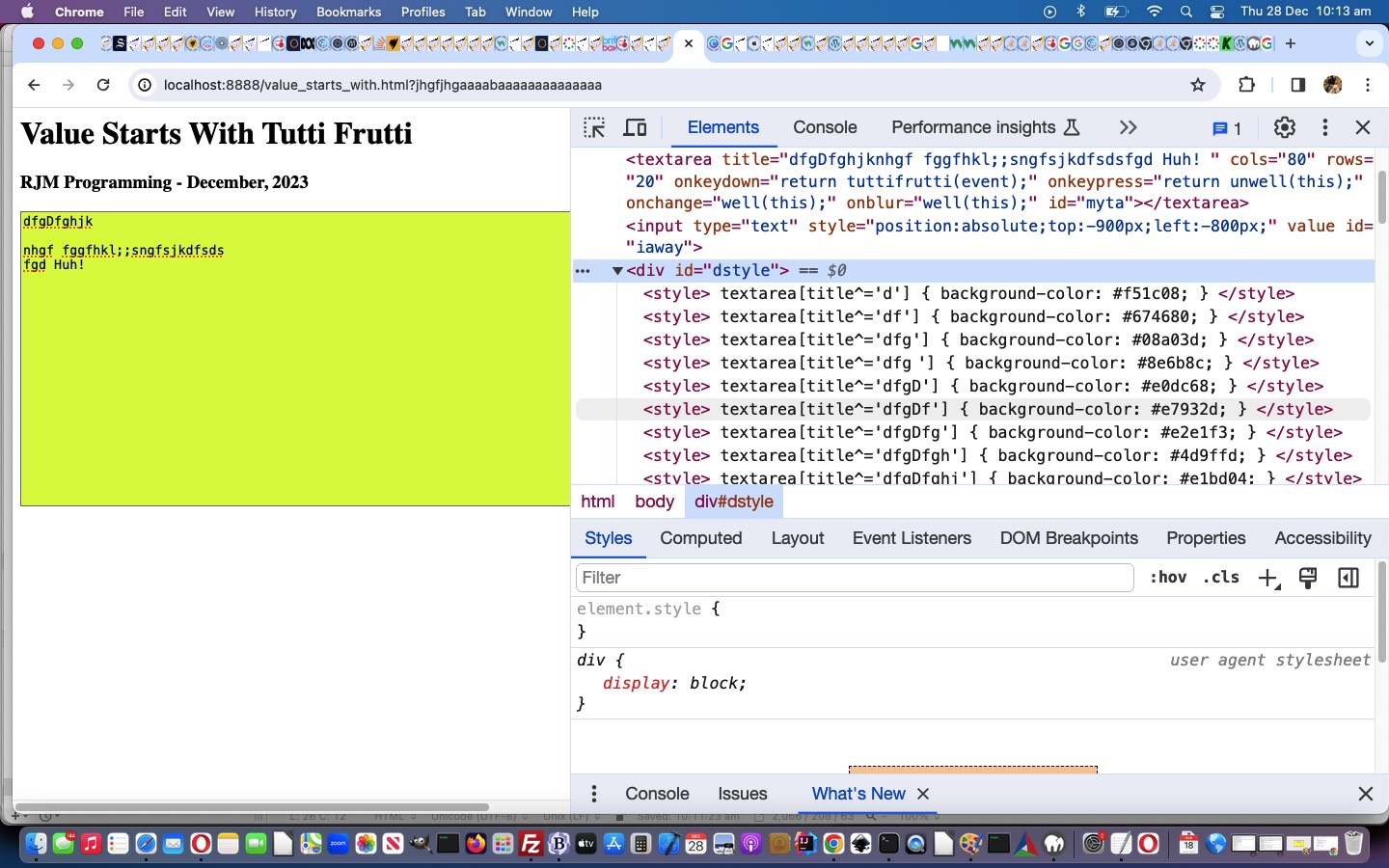The other day when we presented PHP/Javascript Decoding Scrambled Words Game CSS Tutorial there were two CSS selector “starts with” scenarios referenced …
<style>
.guess* { width: 40px; } // thanks to https://stackoverflow.com/questions/13352080/match-all-elements-having-class-name-starting-with-a-specific-string
</style>
… let alone what was used (ie. select element name attribute “starts with” ^ syntax) and opens up interesting possibilities too …
<style>
select[name^='guess'] { width: 40px; } // https://stackoverflow.com/questions/41832255/css-class-name-selector-name-starts-with
</style>
Is there such a selector as …
textarea[value^='text at the start'] { background-color: yellow; }
? Alas, no. But there is …
textarea[title^='text at the start'] { background-color: yellow; }
… associated with the static initial HTML …
<textarea title='' cols=80 rows=20 onkeydown='return tuttifrutti(event);' onkeypress='return unwell(this);' onchange=well(this); onblur=well(this); id=myta></textarea>
… possible, and there are HTML textarea event elements which might help …
- onblur
- onchange
- onkeypress
- onkeydown
… those last two happening ahead of the textarea value being updated, and particularly useful in this scenario. Here are the relevant Javascript functions …
<script type=’text/javascript’>
var colbit='01234567890abcdef';
function tuttifrutti(evt) {
var char = evt.which || evt.keyCode;
if (!evt.shiftKey && String.fromCharCode(char) >= 'A' && String.fromCharCode(char) <= 'Z') {
char+=('a'.charCodeAt(0) - 'A'.charCodeAt(0));
}
var sw=document.getElementById('myta').value+String.fromCharCode(char).replace(/\'/g,'');
while (sw.indexOf(String.fromCharCode(10)) != -1) {
sw=sw.replace(String.fromCharCode(10),'');
}
var colis='';
for (var icol=0; icol<6; icol++) {
colis+='' + colbit.substring(Math.max(1,Math.floor(Math.random() * colbit.length))).substring(0,1);
}
document.getElementById('dstyle').innerHTML+="<style> textarea[title^='" + sw + "'] { background-color: #" + colis + "; } </style>";
return true;
}
function unwell(tao) {
setTimeout(function(){ document.getElementById('myta').blur(); }, 20);
return true;
}
function well(tao) {
//document.getElementById('iaway').focus();
document.getElementById('myta').title=document.getElementById('myta').value.replace(/\'/g,'');
while (document.getElementById('myta').title.indexOf(String.fromCharCode(10)) != -1) {
document.getElementById('myta').title=document.getElementById('myta').title.replace(String.fromCharCode(10),'');
}
setTimeout(function(){ document.getElementById('myta').focus(); }, 20);
}
</script>
… which results in a textarea constantly changing dynamically with its background colour in a proof of concept Textarea Value Starting With web application for the “Value You Have When You Are Not Having a Value”.
If this was interesting you may be interested in this too.



